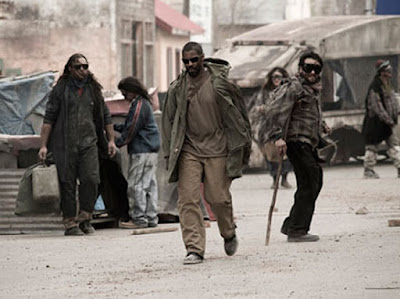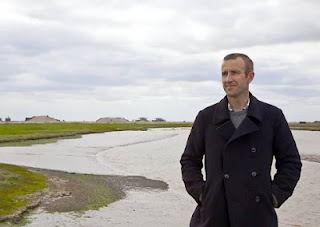Being a pedestrian of international stature (he says self-mockingly, though in fact not quite so full-on ironically as you might imagine), once in a while I do get photographed by some really good photographers. The latest is David Westphal who photographed me for the jwm magazine, that’s the in-house mag of the Marriott Hotel group, so my image will be an adornment to hotel rooms the world over for the next three months or so, which would appeal to anybody’s vanity.
But of course vanity means that you actually worry about looking good. That being the case, I’m always a willing model if not a very natural or comfortable one. In general it’s easier when I’m doing something, and since walking is one of the things I apparently to do best, it made sense to take some pics of me in mid-stride.
David asked if I knew a good location where I might walk and where he might do the shoot. I suggested Griffith Park, up by the old batcave, with the possibility of a view of the Hollywood sign in the background. Cheesy but effective. And one of the great attractions from my point of view was that on a weekday afternoon I reckoned there wouldn’t be many people around, so the potential for embarrassment and self-consciousness would be much reduced. David said that sounded great, but in truth, somehow I didn’t really think it would be that simple.
Come the day of the shoot David had had a better idea. He thought it would be really great if we took some pictures slap bang in the middle of Hollywood Boulevard, sometimes with me walking, sometimes with me standing still as pedestrians swarmed around me. Now I dare say Naomi Campbell would have stamped her little foot and refused, but I am no Naomi Campbell, as you may have realized, and in any case this sounded like a decent idea for a picture, so I went with it. I’m not sure I really had a choice.
And rather a peculiar thing happened. I’m not saying I look especially good or at ease in the pictures, but in the event I felt remarkably unembarrassed and unselfconscious during the shoot. I guess it has something to do with the nature of Hollywood Boulevard. First of all, whatever you’re doing there, however odd, there are always going to be plenty of people doing much odder things: a man dressed in a SpongeBob SquarePants costume, some guy forcing his CD into the hands of unwilling tourists “Well you gotta take it now ‘cause I’ve signed it for ya,” a male/female busking duo who seemed to be making up their songs as they went along, at one point launching into the lyrics, “Lick, lick that jellybean, lick it lick it till I scream.” The chaos was oddly liberating.
Needless to say, again unlike Naomi Campbell, I didn’t have image approval, which is why they didn’t use the pic at the top of this post. You might argue that this isn’t actually a picture of me walking, but it’s the one I liked best. It has so much going for it: a tyrannosaurus, a bunch of overdressed hipsters, and the author, staring into distance, not exactly relaxed, and by no means above it all, but detached and aware and observant. That sounds quite a lot like me. They used this one instead, which again doesn't actually show me walking, but is still a great picture, even if it makes me look a little over-chunky - vanity, indeed.
The piece is written by James Bradley, who runs a Brooklyn record store (yes really) named Soundfix and he also plays alto sax saxophone under the name Beauclerk. “Low-resonance, high-discomfort ambient drifter Beauclerk is a one-man drone menace, mixing glory and danger via saxophone and a Line 6 pedal,” says the Village Voice.
The jwm piece features a playlist of music that a pedestrian might listen to when walking the streets of Los Angeles. I’ve done these lists before and it’s very hard to stop yourself being “hipper than thou,” and I can’t swear that a list containing John Cage and Christian Fennesz entirely escapes that accusation.
And of course my original list was longer. I’m not complaining: I understand the realities of putting together a magazine, but as a little bonus, let me recommend one song that ended up on the cutting room floor:
Johnny Tyler and His Riders of the Rio Grande, ”It Ain’t Far To the Bar (But It’s Such a Long Road Back).” The story of all our lives.
Johnny Tyler and His Riders of the Rio Grande, ”It Ain’t Far To the Bar (But It’s Such a Long Road Back).” The story of all our lives.
James Bradley’s Soundfix website is here:
Beauclerk is here:
David Westphal’s website is here:
The jwm magazine is here, though my computer found some of the bells and whistles a little too fancy to deal with easily, yours is better no doubt:































